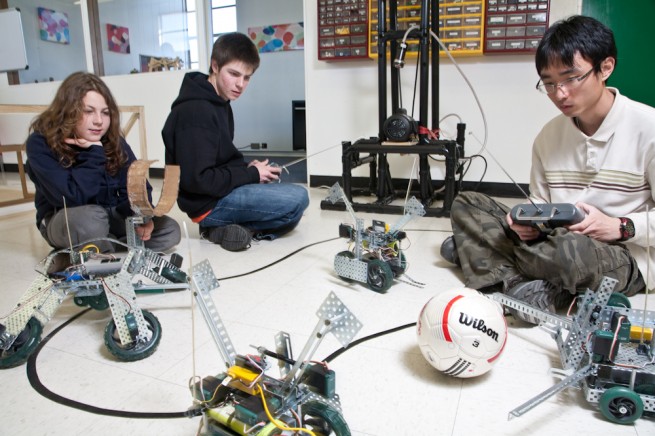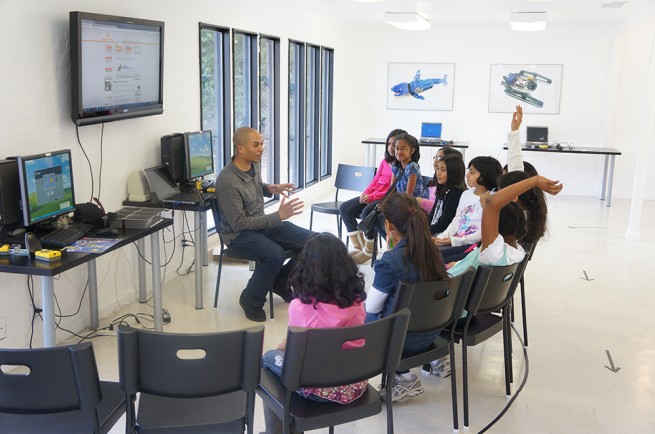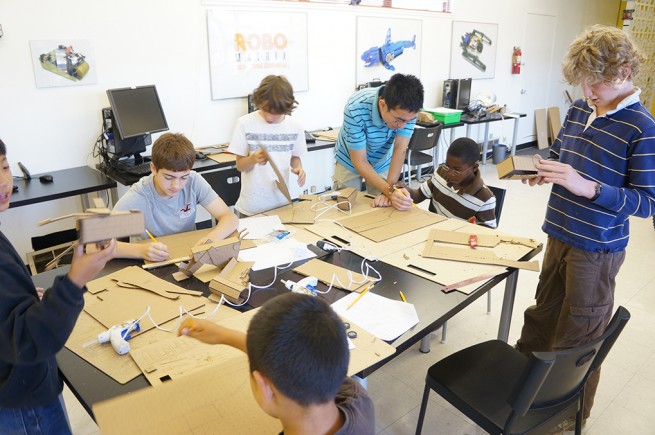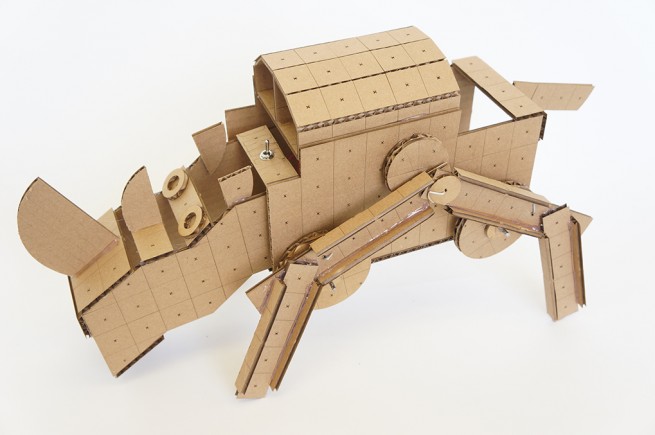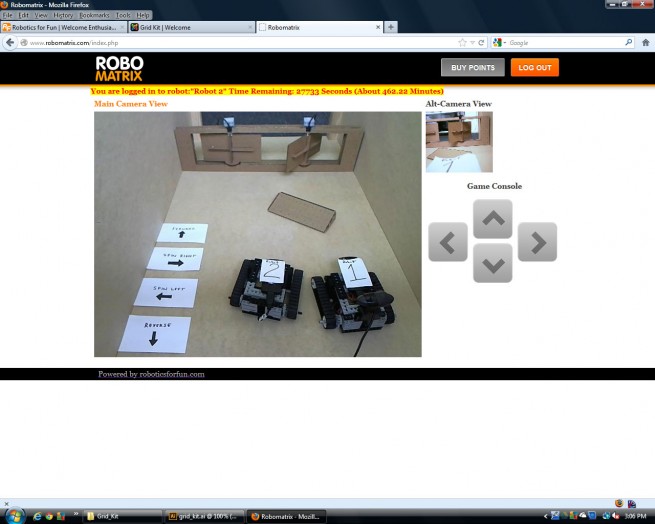GamesBeat recently visited Robotics For Fun (RFF), a small business in Oakland, CA., that works with creative children. And we’re talking some very creative children, as some of the images below will demonstrate. Using RFF’s proprietary Grid Kits, which are laser cut and packaged on-site, working “robot” models — from alligators and dragons to machines and humanoids — can be built out of the box.
But as impressive as the many creations lying around were, we were especially intrigued by The Robo Matrix, a highly ambitious project that allows users from all over the world to log in and control a livestreamed, motorized robot at the RFF office. The virtual and web design aspects of The Robo Matrix project also teach students highly valuable programming skills, in addition to design and engineering.
GamesBeat sat down with Robotics For Fun founder Jutiki Gunter to discuss the motivation behind the company, the multi-tier workshops available to students of all skill levels, and what the future holds for their innovative creations and products.
[vb_gallery id=580191]
GamesBeat: Sorry I’m late, I actually drove around the building 10 times. There isn’t a sign on the door or anything. Is that because of the neighborhood?
Jutiki Gunter: It’s interesting. We never put a sign out. Early on, we couldn’t afford it, really. Then, because of privacy, because there are kids we work with, and because of the neighborhood at the time, we didn’t want to attract attention. The perception about Oakland is that it’s a very bad place, and people are sometimes hesitant to come to Oakland. It’s just the way it is, even though it’s a wonderful place to live, a wonderful place to be.
GamesBeat: This is my first time to Oakland. I won’t lie; I got off the freeway and immediately feared for my life.
Gunter: (laughs) Yeah, but I’m telling you, it’s a really great community. A lot of great people, a lot of great talent. It’s not as bad as people think. Actually, some of the parents that bring their kids to the program are leading in venture capital, leading writers, Pulitzer Prize-winning writers. Oakland-based people, Berkeley-based people. We get international students who come here every year. They want the experience for their kids, and they can get past the perception of Oakland. But we just don’t have a sign because we never did it and we don’t want to attract… People just walk up the stairs into our space during class time. So we prefer to be discreet about it.
GamesBeat: Some of the best clubs in the world are supposedly the unmarked ones hidden away in some dark alley.
Gunter: Yeah. It’s almost become a stylistic thing for us. We like to say we’re the best-kept secret, even though we don’t really want to be. But it’s a low profile.
GamesBeat: You have quite a few things going on here. I guess we should start with a bit of the company’s history.
Gunter: I started [Robotics For Fun] in 2004. I was teaching robotics at Chabot Space and Science Center. They saw my background in architecture, the media work that I’d done, and they thought I would be good to teach their robotics. So I learned robotics, and then I taught that summer. The kids would come to class early and they didn’t want to leave. They didn’t even want to take snack breaks. I thought, “Wow, there’s something here. Maybe we should try to do this year-round.” At the end of that summer camp that I was teaching, I opened Robotics for Fun. I spent about three or four months promoting it. Then people were calling, and when they took the class, they would come back and come back.
Every month was like a milestone for us. But the first three or four years, it was still just part time. We were doing it casually. Four years ago it became my real gig. I was able to start hiring staff. We have a strong enough membership base where we could do this as the main business. That’s how it happened. When we started, we were mainly working with 13- and 14-year-olds. Over the last four years, we’ve learned how to teach much younger, and we’ve seen more interested students at a younger age. Now we teach as young as six, all the way up to 18-19. A lot of the kids who started with us have been in the program four or five years. Some of them we’re seeing go off to college now. One of the first girls to come from our program, she’s studying computer science. We just had another student who was here for about three years, he’s at Berkeley in engineering.
We’re confident about our model. We’ve done some great projects. We know how to communicate with the kids. Now we’re just trying to take that to more people. Every year we’ve had international students call us and say, “Hey, we’re going to be in the states for a couple weeks or a couple months, can we take a class with you?” We’ve done Hong Kong, India quite a bit, Australia. We’re starting to have a reputation for being good at it, and we have a really good community of people.
GamesBeat: Do you have direct competition from anyone?
Gunter: No. I would say… No, because we’re the only place I know of that does it year-round. A lot of people, even like First Lego League, Galileo camps, stuff like that, those are just short week-long camps or eight-week camps. What we try to do is create an environment where they can come year-round and learn robotics.
GamesBeat: How many non-member visitors do you get on average, and how many active members do you have?
Gunter: We try not to share our membership numbers per se, but I would say… Like I said, with the LivingSocial [deal], we had just under 500, maybe 450 people signing up in a four-month period. We have huge numbers of introductory students, and then that number tapers off as they get to the membership. With our direct promotions, maybe two out of 10, one out of 10 become members. Probably 25 to 30 percent will take our advanced camp. So they’ll do the intro class and then take the advanced camp, which is four classes.
Then the membership is the expensive level. It’s $240 monthly, so you don’t have a lot of people who can support that. What happens is, even though we’re in Oakland, people think we deal with a lot of minority students, but no. Fortunately or unfortunately, we’re only dealing with these private-school kids. We offer some scholarships, but because of the price point, it keeps a lot of people unable to participate. Because we’re for-profit, it’s difficult for us to support a lot of those students, even though we do. We’d like to support more. But we don’t get government financing for it.
GamesBeat: What does a monthly membership get you?
Gunter: The monthly membership gets you four classes per month. You can attend once a week. You work theme-based projects throughout the year, and our classes are small. Every student works individually. When we do a project, every kid can work at their own pace. They have all the equipment they need for an assignment. They’re often able to take their projects home, which a lot of other programs don’t offer. They get that hands-on attention, both in building and programming. I think that’s why they stay so long. They’re getting that individualized attention so they can expand on their own interests.
GamesBeat: Aside from the individual projects and models, you also have some larger products or projects going on. One is the kit…
Gunter: The Grid Kit?
GamesBeat: Yes. Are you selling that nationally… internationally? What can people accomplish with that?
Gunter: The Grid Kit I created because I’ve seen the price of these other kits increase a lot. I’ve also seen kids reach a certain age where they don’t want to work with those kits anymore. A 13-year-old kid, even though he can do amazing things with Lego, he doesn’t want to work with Lego. He’s a teenager, he doesn’t want to be associated with Lego. It reaches a point where the kid doesn’t want to work with it and the prices are outrageous, or they’re getting so good at building robots that they can’t express their ideas with those things. So I spent a while teaching kids how to make models out of cardboard. I was doing that for some of our projects. If I had a concept I could make it out of cardboard, quickly and inexpensively.
Then I started teaching the kids how to do that. It still wasn’t enough, so I came up with the Grid Kit. It’s an 18″ by 24″ sheet of corrugated cardboard. Laser-cut into the surface is a grid, a one-inch grid. Within that grid there’s a series of Xes. Those Xes help them mark the center of the squares, and it makes it so they can punch holes pretty quickly. Then I gave it to them for a project and their eyes just lit up. The immediately saw the potential. Now I’m seeing them do work I haven’t seen done with any of the other kids. Lego, VEX, Parallax. It was mainly about… How do we get them to express themselves better? How do we make something affordable? We’re spending so much every year. We cut a piece, we can’t re-use it. The piece isn’t big enough. We can’t color it…
GamesBeat: You’re talking about the Legos…
Gunter: Yeah, Legos and VEX and Parallax stuff. So then we started doing the Grid Kit stuff with the kids, and we saw their work just explode. Much more creative. We also saw that students could use it, we the staff could use it, and adults could use it. We were testing it all through our group. We started selling, and the first order came from the November 11, 2011 Hackathon. They purchased 111 Grid Kits with 111 Arduino boards and gave it to 111 students and professionals to work with for 11 hours. They came up with a bunch of things. Then we had Microsoft follow up with an order for some of their outreach.
We’ve been selling kits across the country. Mostly in California. Florida. People buying the standard Grid Kit. We got an order from a technology company in Silicon Valley. Willow Garage, I was excited to see that, because those guys are doing some good work. We’ve seen it grow. At first, for months, we just had the standard Grid Kit, which was for a more advanced builder. Now we’re starting to do the robot, the alligator, the fish, some basic models, just to get people familiar. We’re giving those out and people are buying those. The two popular ones happen to be the alligator and the robot. [laughs] People are using it.
GamesBeat: And what is the The Robo Matrix?
Gunter: The Robo Matrix started as a project we did for students. I came across an article about “Robots Go to War,” and I changed the theme to rescue robots, because I wanted to be more positive with the message. We built robots that could leave a base, go out to an outpost, get medical supplies, ammunition, or water, and then deliver it to a soldier. The theme was, a helicopter had gone down and they had to build a robot that could do all of this autonomously. We built a site to do that.
A couple years passed. We revisited the project, and we did it so they could program the robots in real time through the internet. Then I started thinking that maybe this would be great for others outside of Robotics for Fun to be able to do. We built the Robo Matrix, and it allows us to add as many robots as we like. People anywhere in the world can access those robots and drive those robots around. We’ve been trying to come up with a specific gaming theme. We’ve experimented with it a lot. Now we’re thinking of having more of an environment where people can experiment and play.
GamesBeat: Where would you like to see it go in the near future? What’s next for Robo Matrix?
Gunter: I think we could build a fun, interactive gaming environment. But it has a lot of other applications. I think it has great security applications. Accessing remote regions, like you were saying earlier. You could put one in the desert somewhere and be able to access it. A lot of people have talked about space as a possibility. So what we’d like to do is just continue building on the technology and try it in a bunch of different formats. Try it in all of these other environments and other applications.
GamesBeat: You were telling me, with the Robo Matrix and the idea of doing battle bots, that you try to stray away from violence.
Gunter: Yeah… It’s interesting. The kids have a natural inclination to battle. When they do their intro class and their robots are driving, if they collide, they love that. [laughs] It’s a natural instinct they already have. We try not to get the kids in a frenzy. They get competitive. Kids cry. Some kids shut down. That, along with all the other… I don’t think the parents necessarily want to see it.
When we built the Grid Kit I was like, “Wow, this will be great, we we could make them into battle bots and people could crash the Grid Kits or repair them or get another Grid Kit and redesign it…” I was thinking along those lines, but then I thought, “You know what? That’s not who we are.” We’ve never really done that. Even though the Grid Kit would be great for that, we don’t feel like that’s who we are. I asked a parent about this. One parent said, “No, it’s not something you should do. You’ve never done that. We like the way you teach our kids.” They kind of appreciate that we don’t do that. But from a business perspective, I was like, “The Grid Kit would be great for that! When they crash it’ll really crash!” But we decided that’s not who we are.
GamesBeat: You guys don’t have a very large space, but you’ve accomplished a great deal here. Especially with The Robo Matrix, I’m excited to see where that goes.
Gunter: Do you have suggestions on how you would approach that?
GamesBeat: In what regard, specifically?
Gunter: It’s funny… The theme. That’s what we’ve been trying to figure out. We’ve tried to come up with all these reasons why someone should do it. For me, the idea of just driving a robot remotely is exciting.
GamesBeat: Controlling a robot from your computer screen is initially exciting, but once you’ve done it, it’s like, okay, now what? I think capture the flag is a really good, relatively nonviolent activity. You could also evolve it towards schoolyard games like freeze tag, where if the person who is “it” touches your robot, it shuts down for like five seconds or whatever. Something like that.
Gunter: There are so many things.
GamesBeat: Definitely. Simple games, but that have some kind of objective. You’ll have players who don’t care about the objective. They just want to ram into things. Maybe just driving it around is enough for them. They’ll be over in the corner doing whatever…
The other thought I had, and this is just a broad idea, but right now, procedural gaming or totally open-ended… Like in Grand Theft Auto. It was open-ended, because you could go wherever you wanted, you could climb… You could play Grand Theft Auto and not kill people. You could be a paramedic. If you hopped in an ambulance you could go and save people and never kill anybody. You get out of it what you put into it. Now, with games like Minecraft and other games like that, they give you this almost blank slate of basic features, and you go and say, “I’m going to build this. I’m going to dig this giant canyon here and pour lava in it.” Procedural and open-ended gameplay is definitely where some of the biggest successes in gaming are right now, so perhaps applying some element of that to The Robo Matrix could really help build user retention.
Gunter: It’s interesting, because the kids, they always talk about Minecraft. Everyone. I get so many kids coming in here, and I keep asking, “What do you guys like about it?” They’ll go online and they just like doing stuff. Random stuff. Everybody’s doing something different. It’s wide open. I asked them, “Can a real environment compete with that virtual environment?”
If The Robo Matrix does well, perhaps the two can co-exist, and that’s what makes it so exciting. You can check out the Robotics For Fun site for more information on the Grid Kit, Robo Matrix, and workshops.
VentureBeat's mission is to be a digital town square for technical decision-makers to gain knowledge about transformative enterprise technology and transact. Learn More
